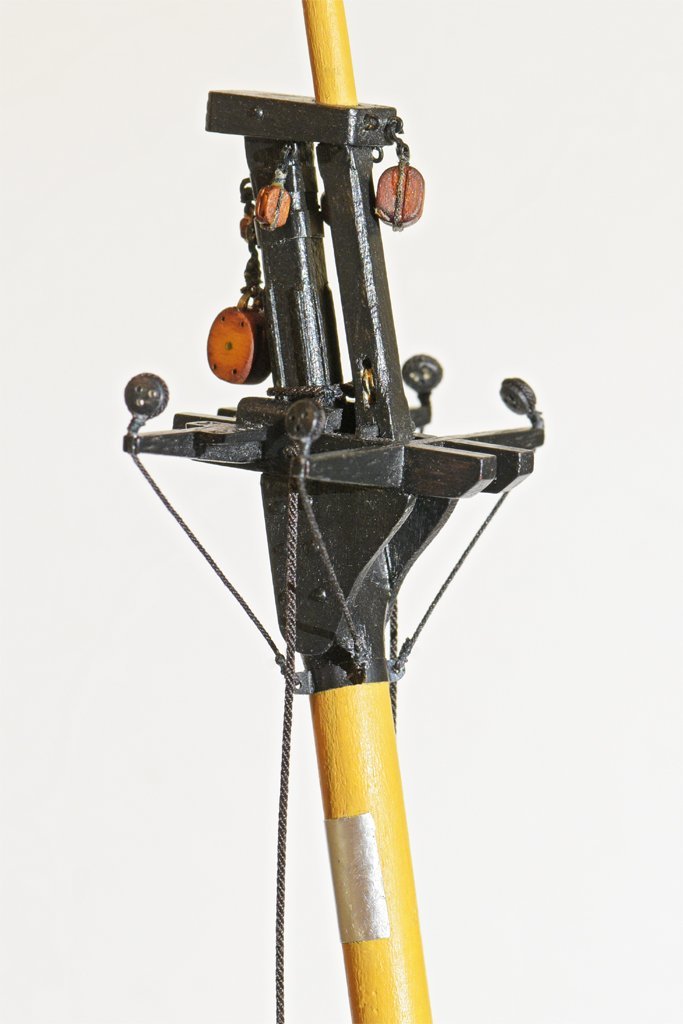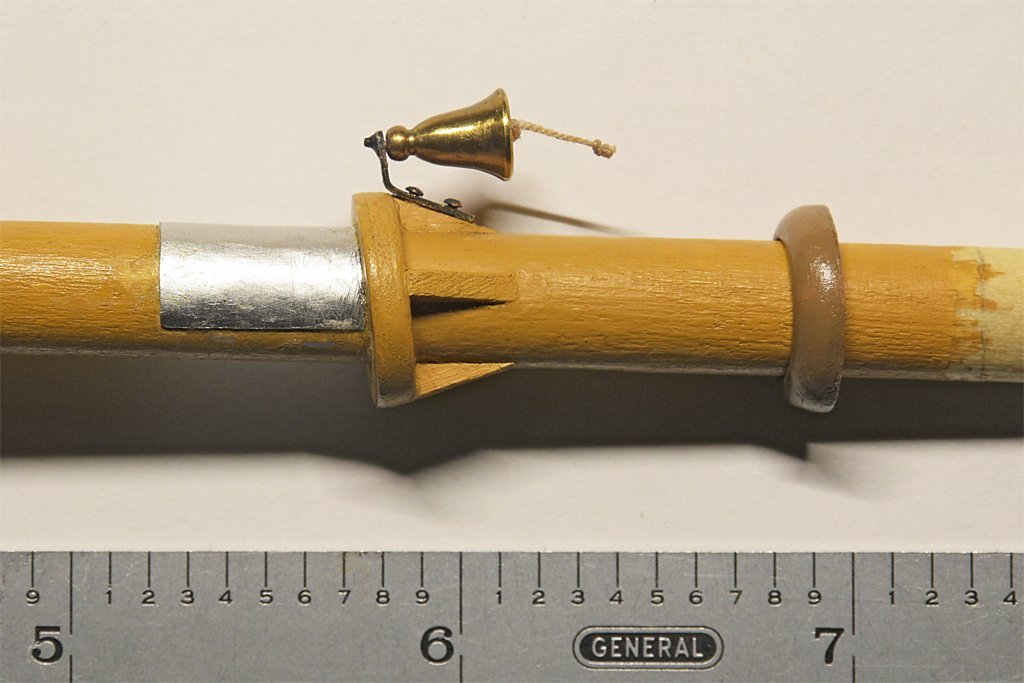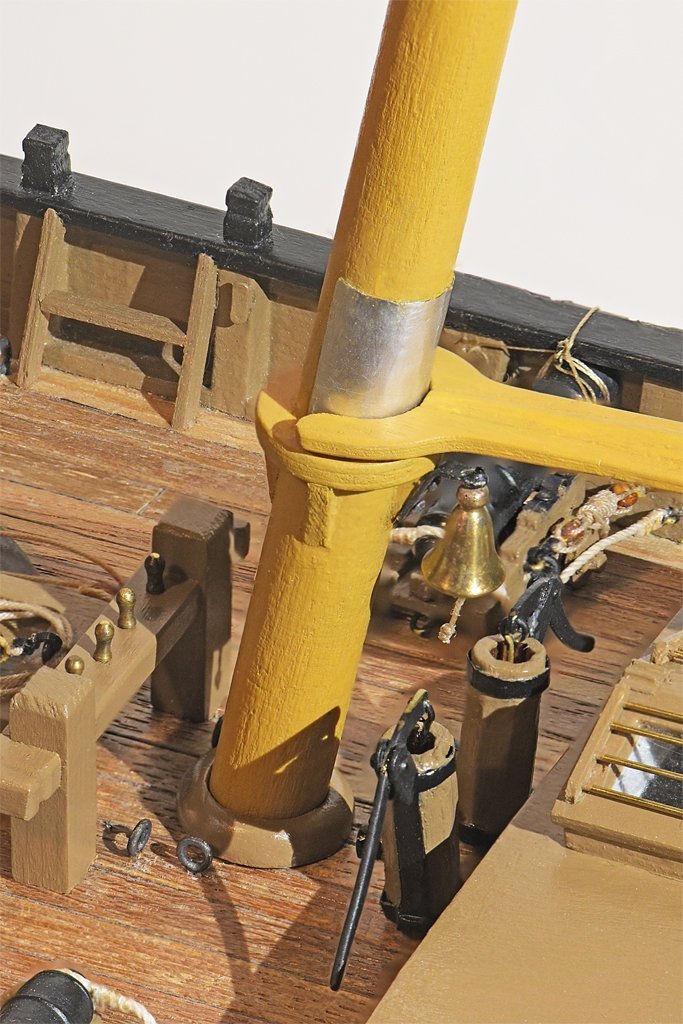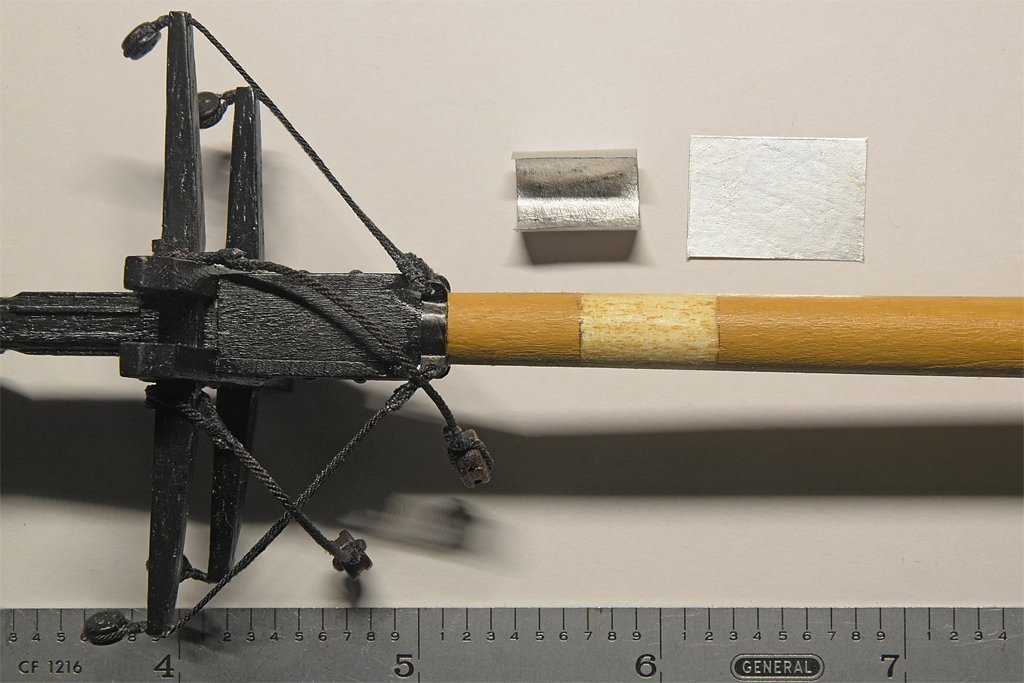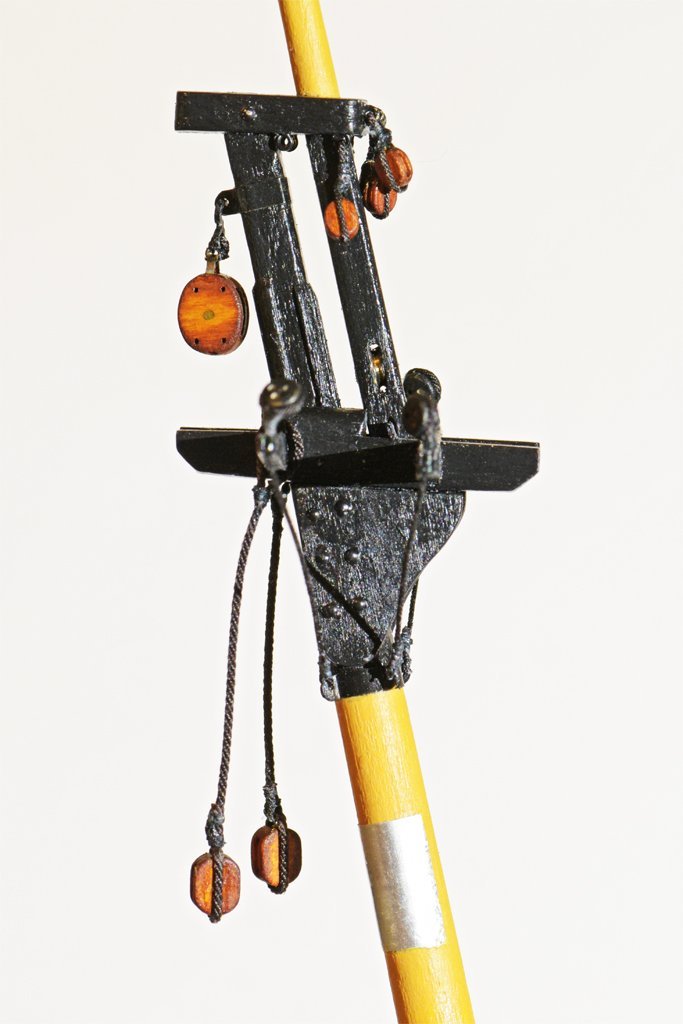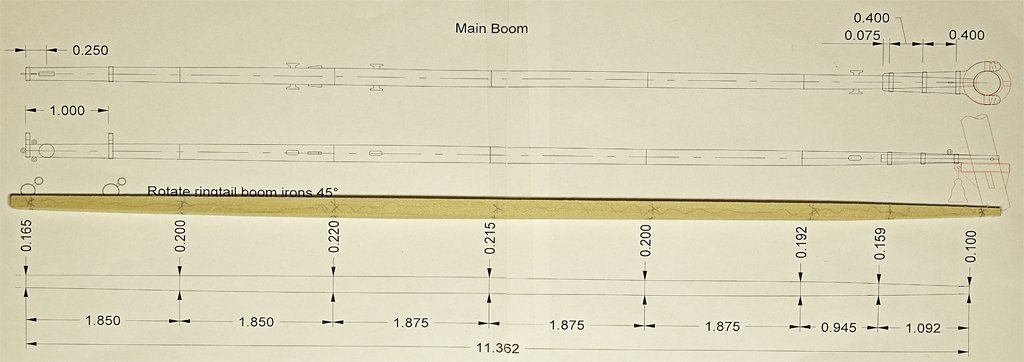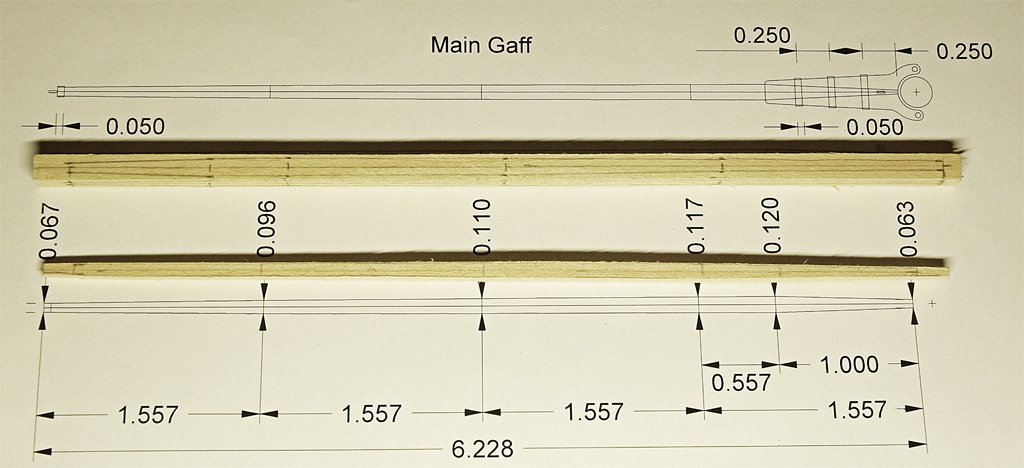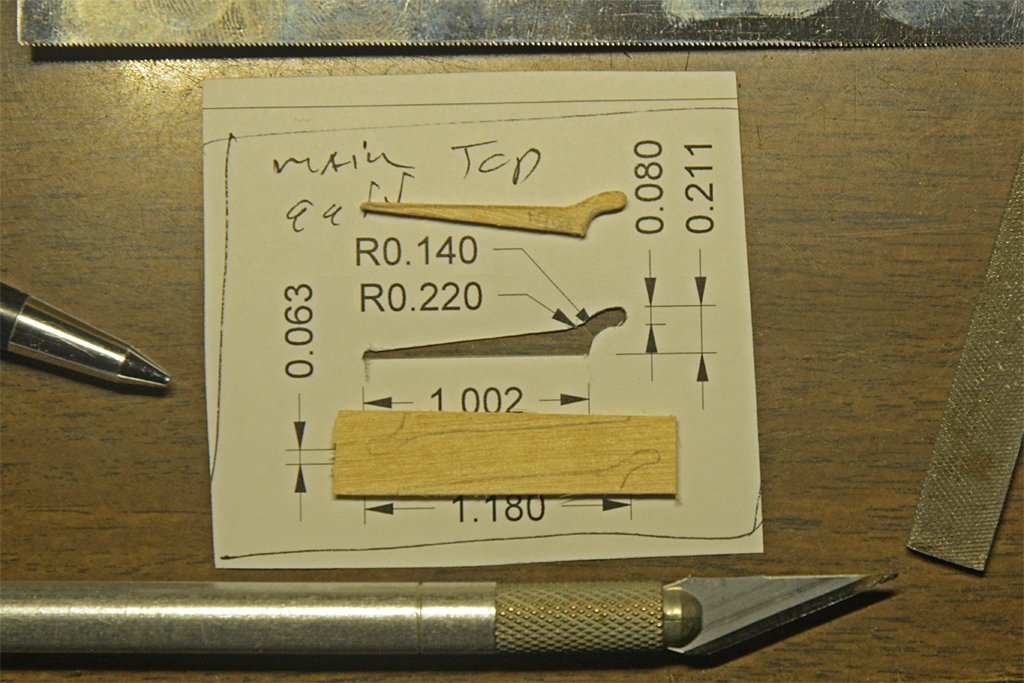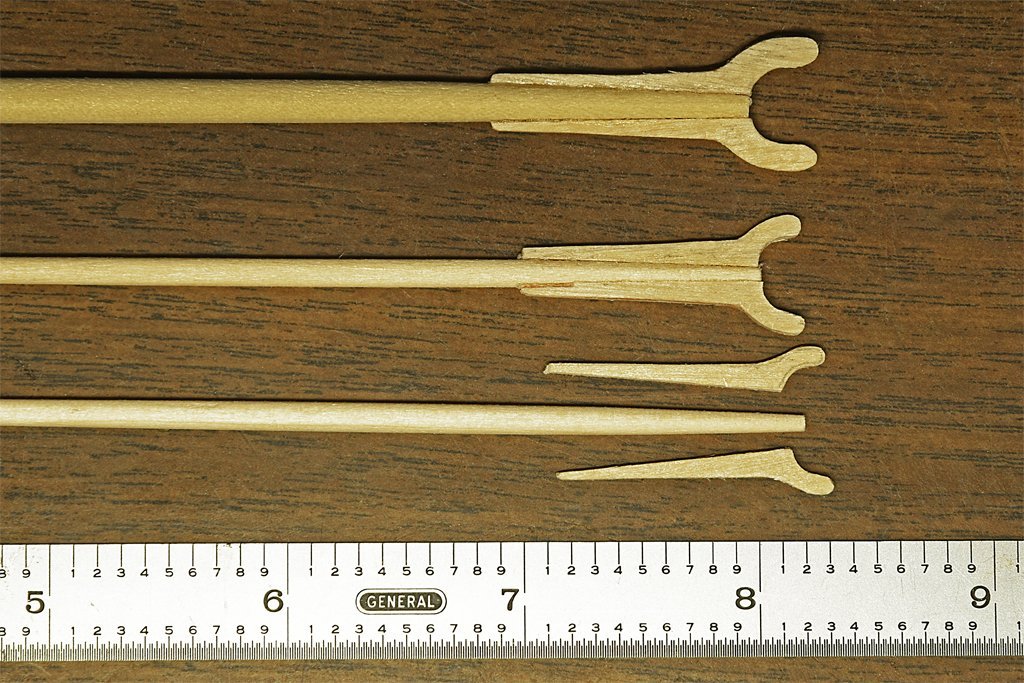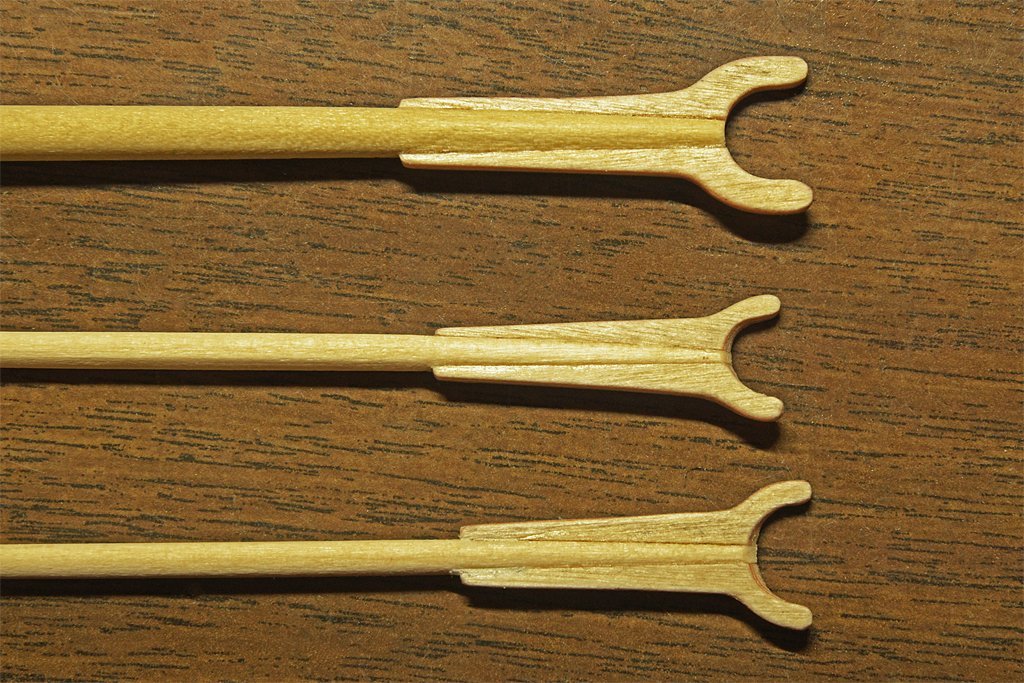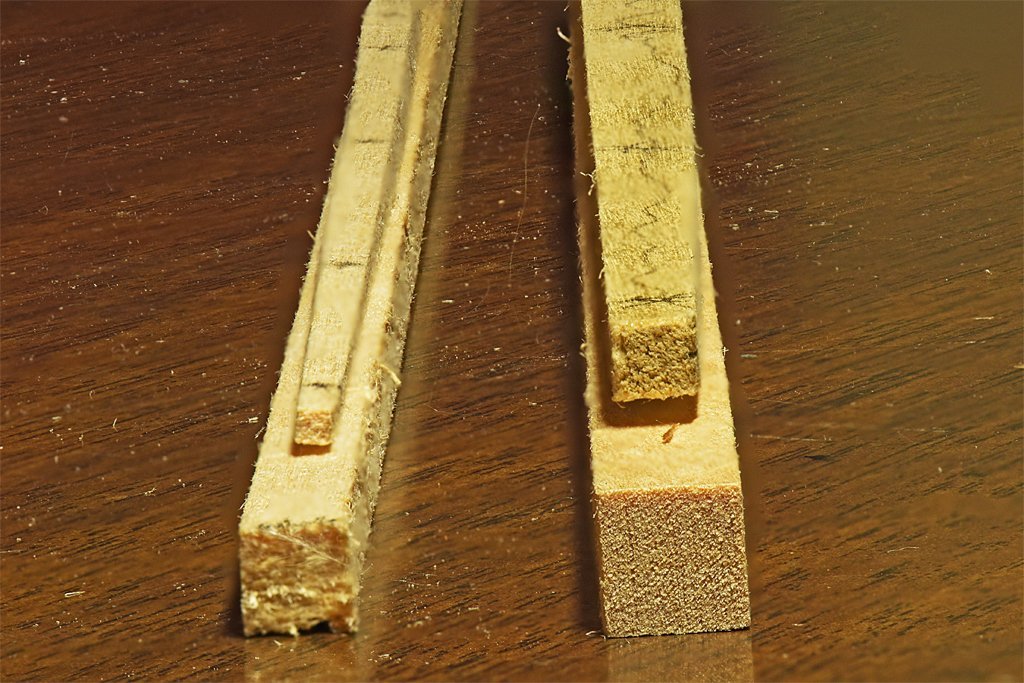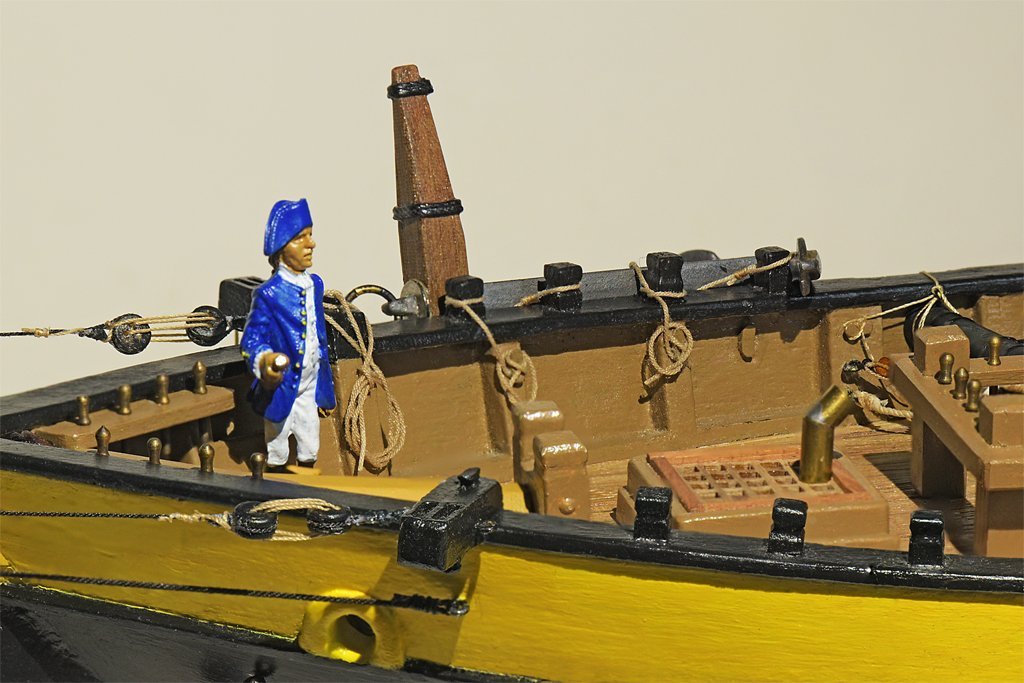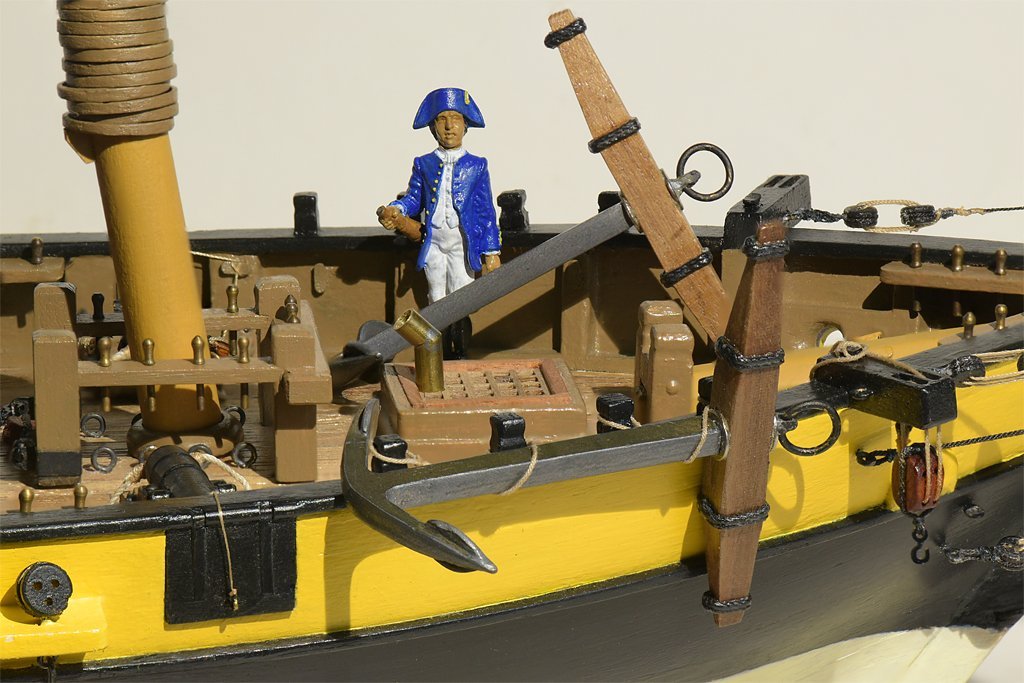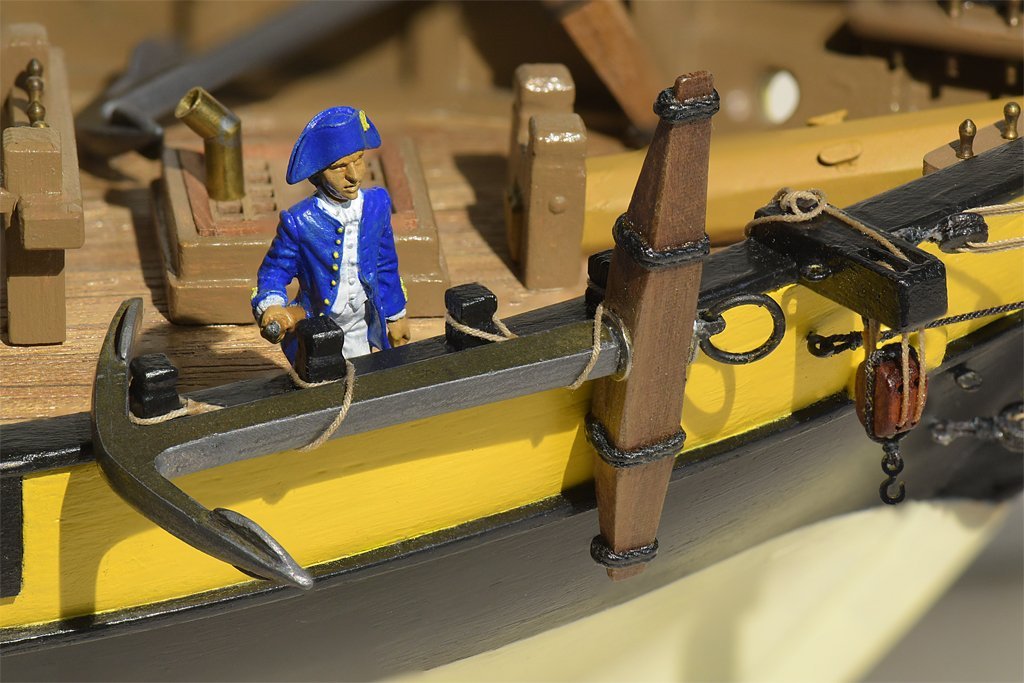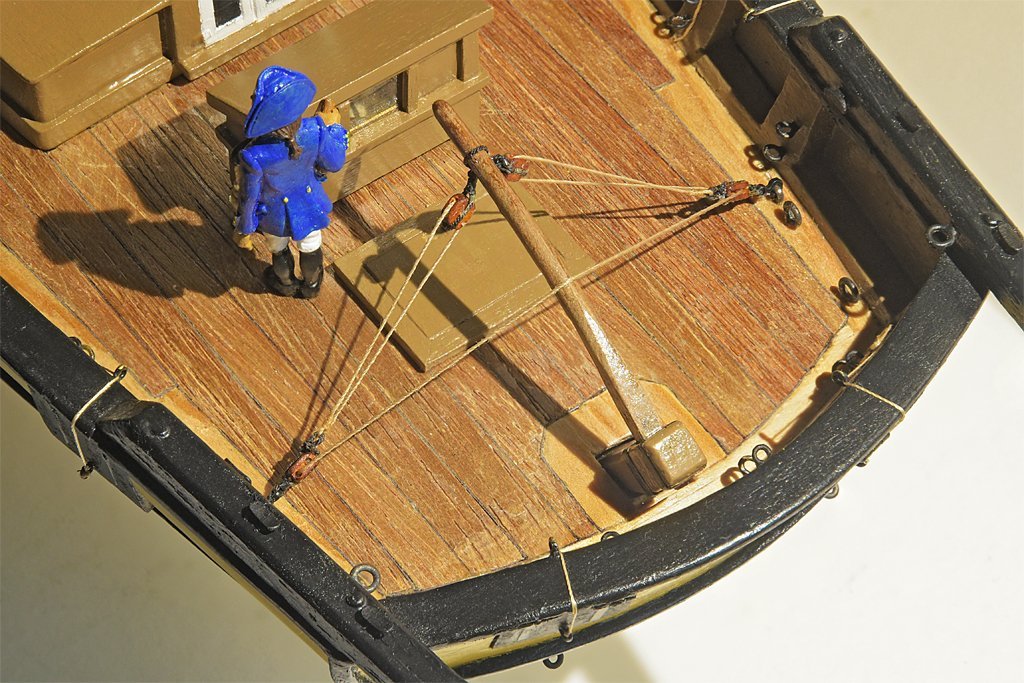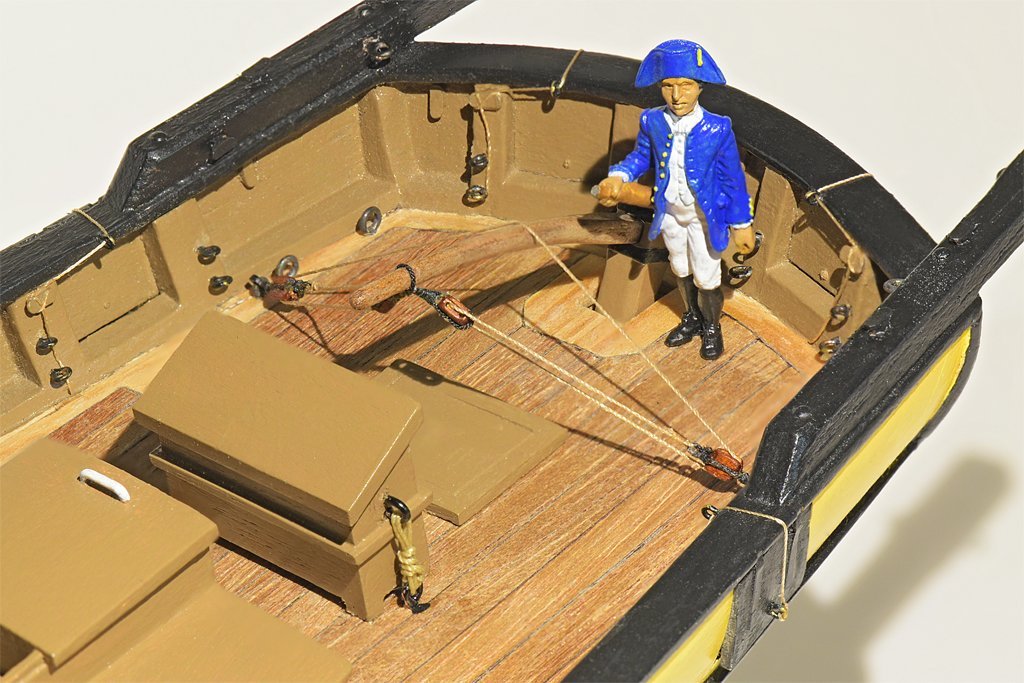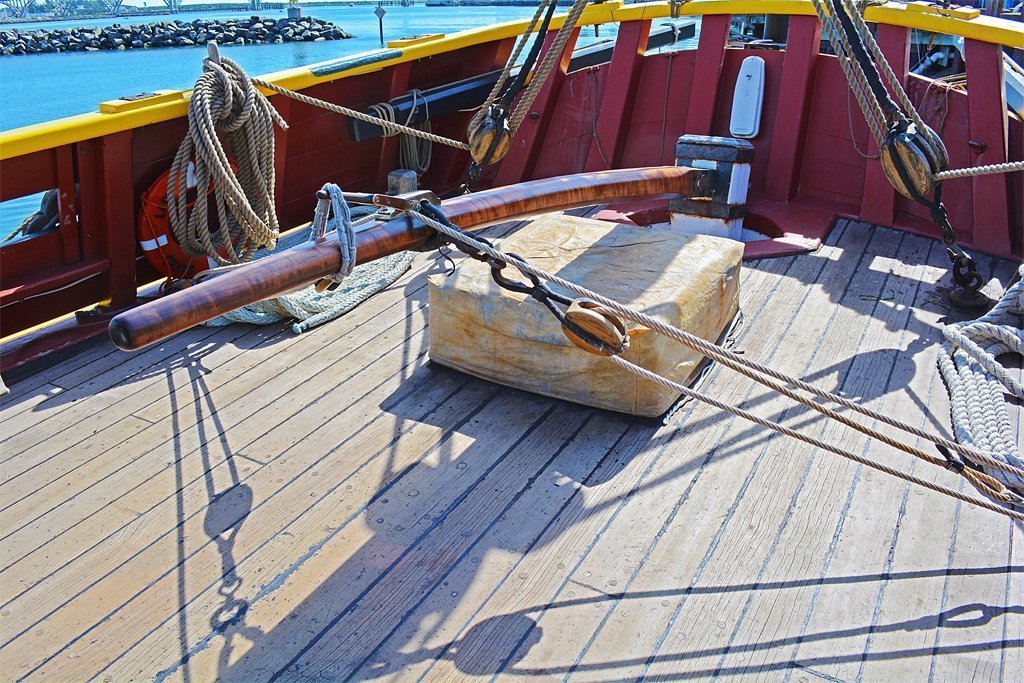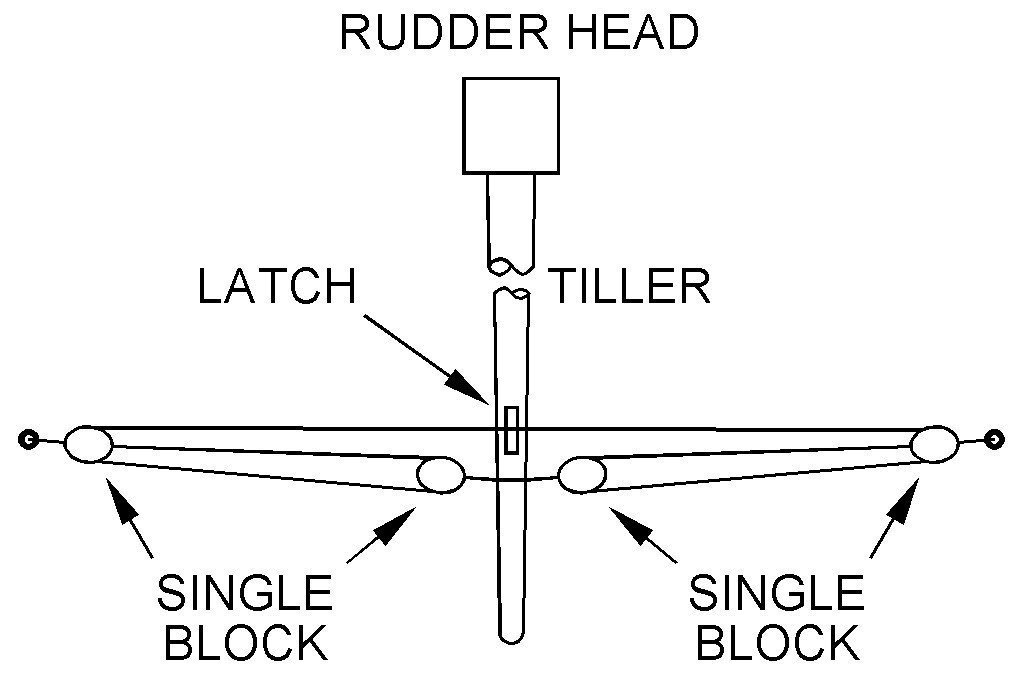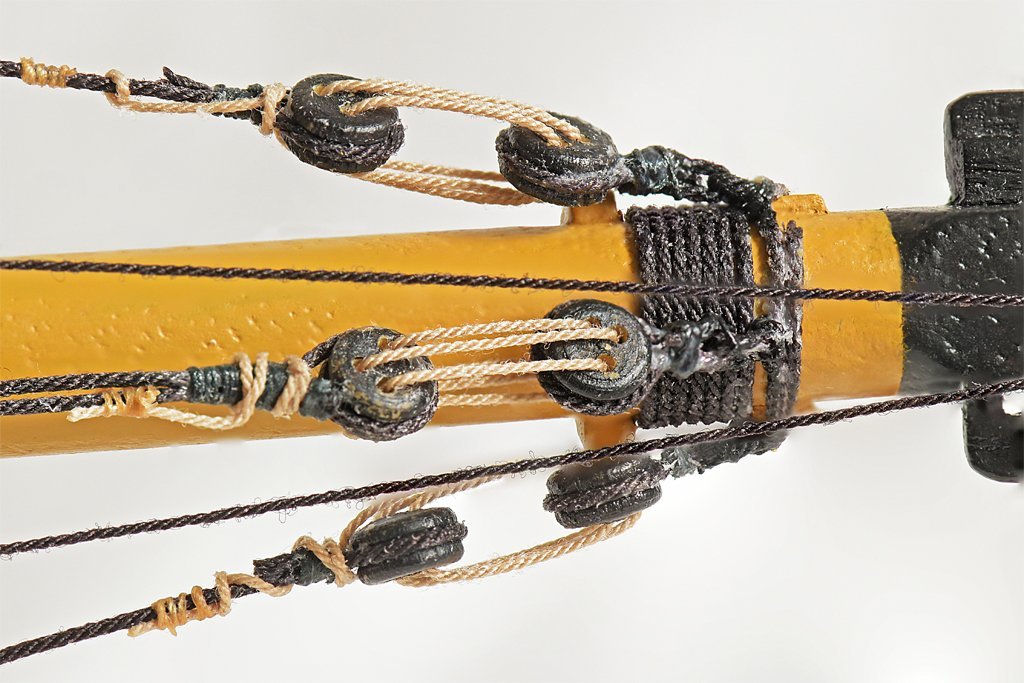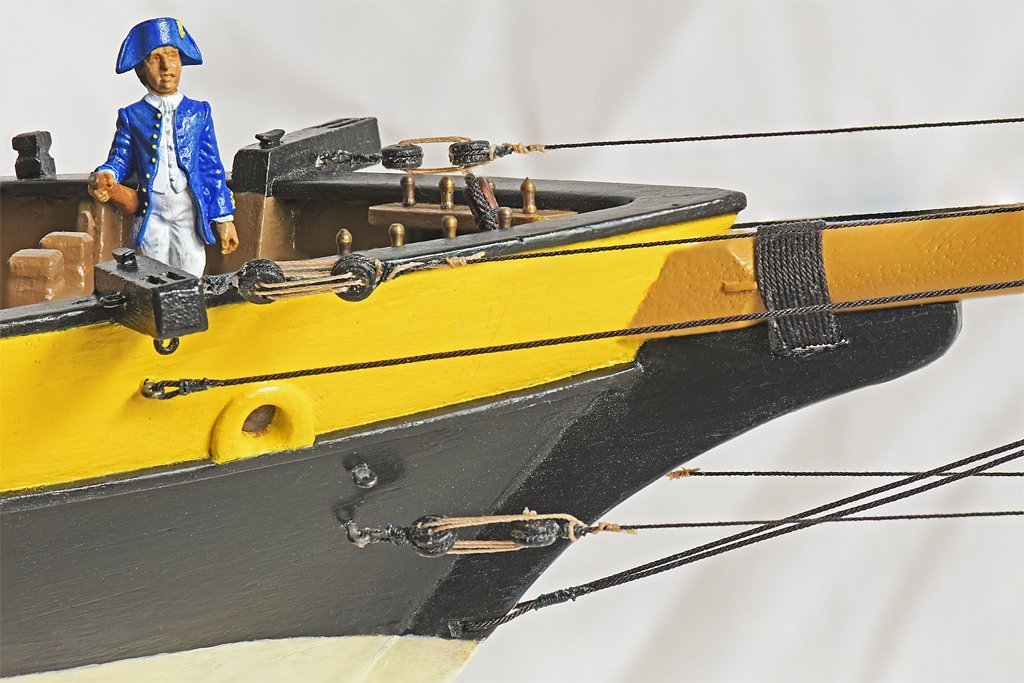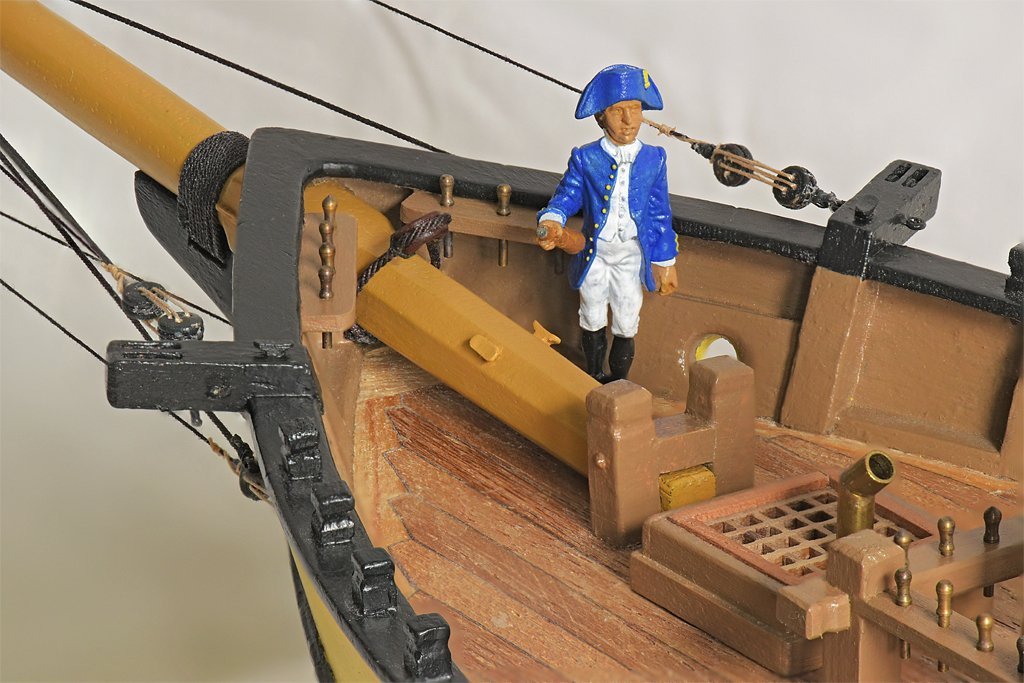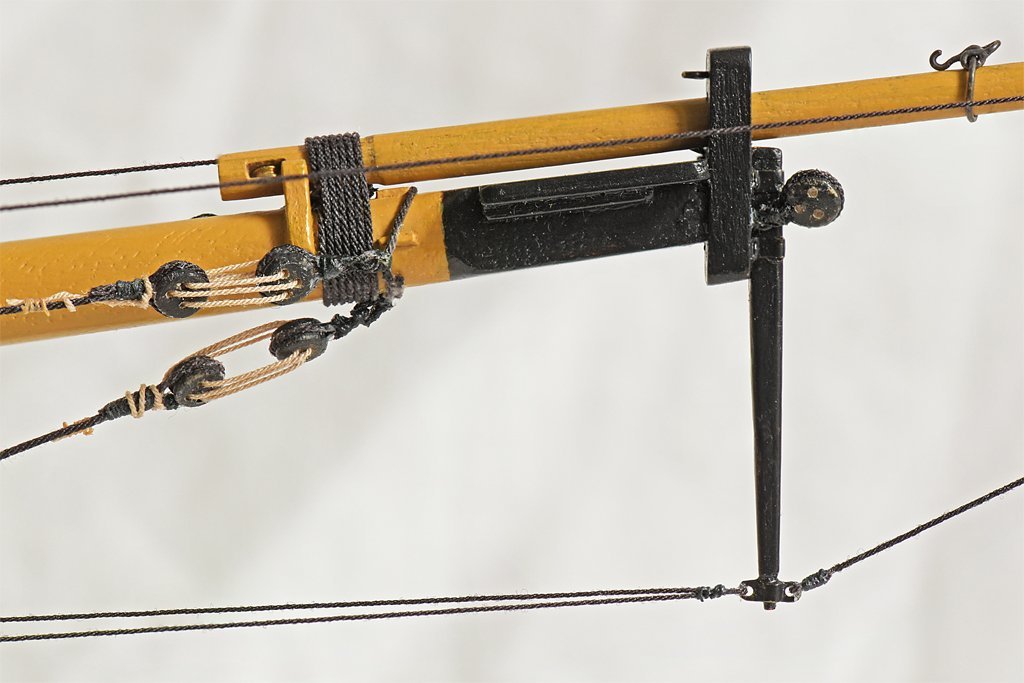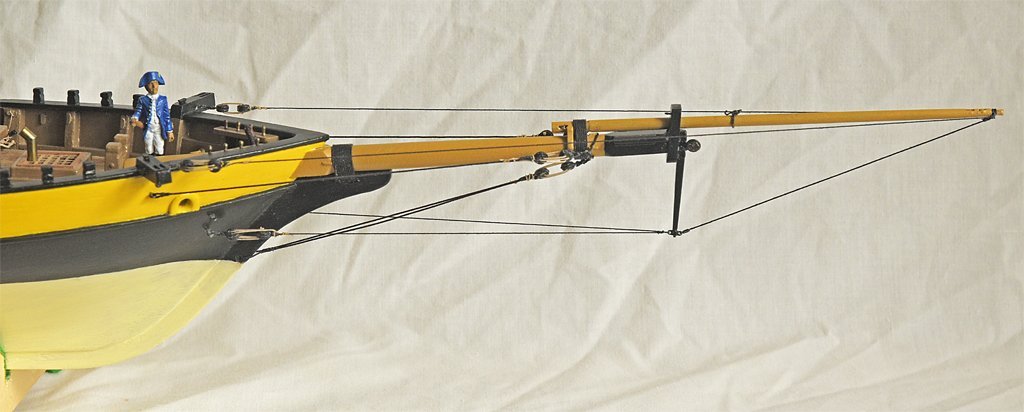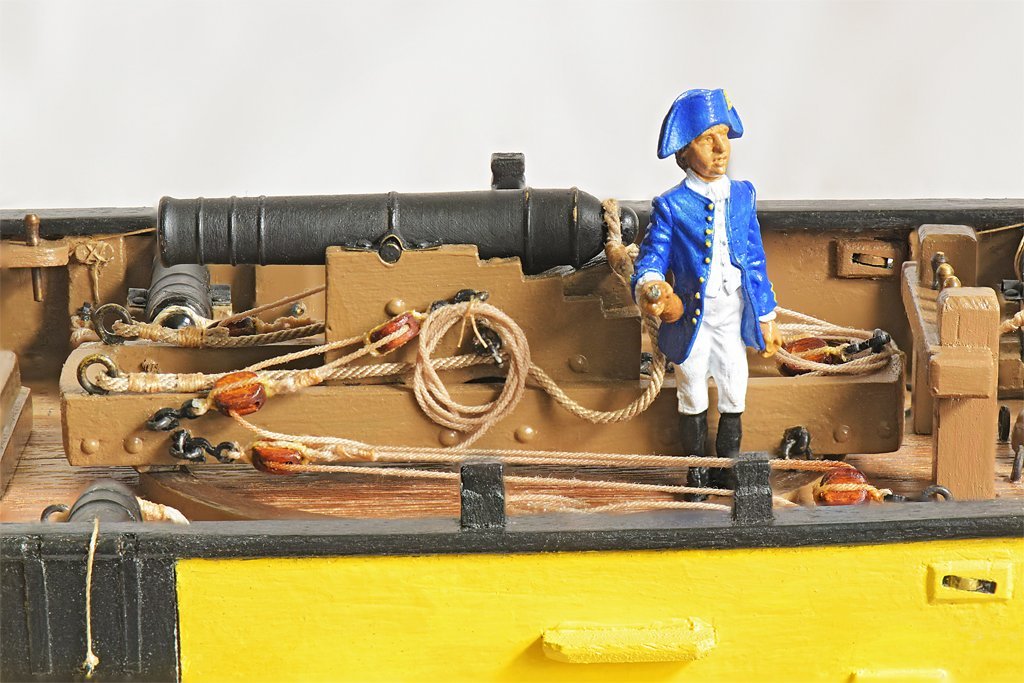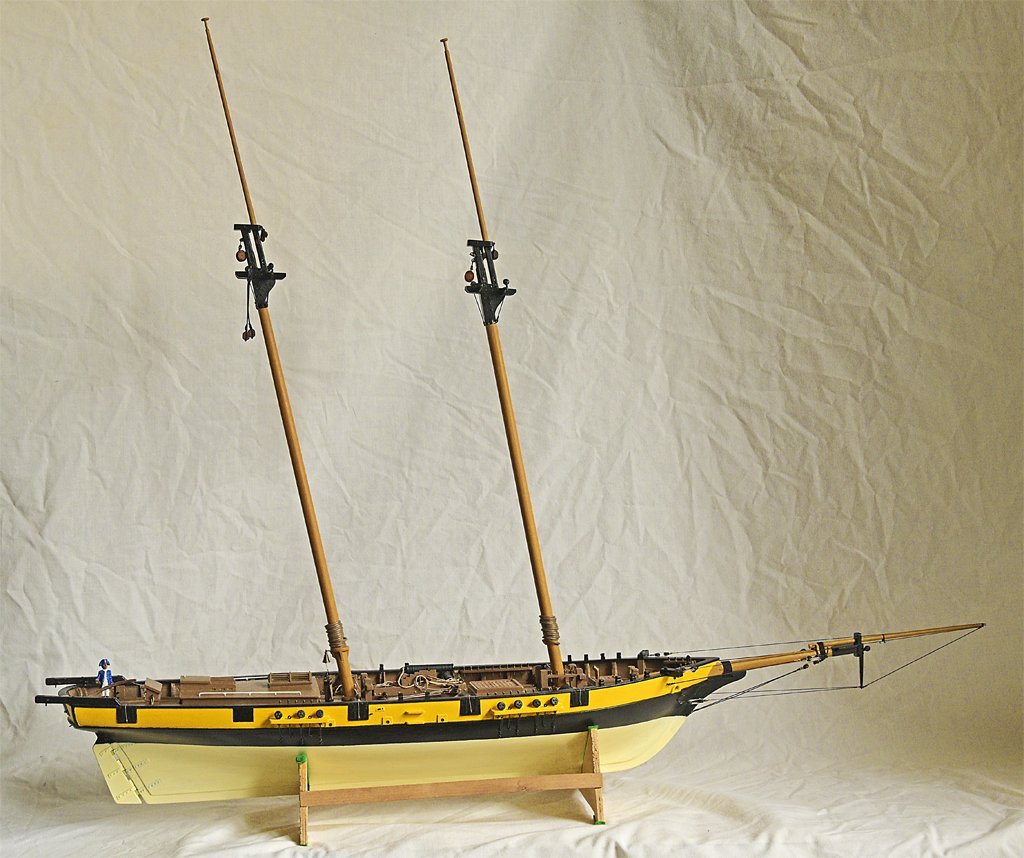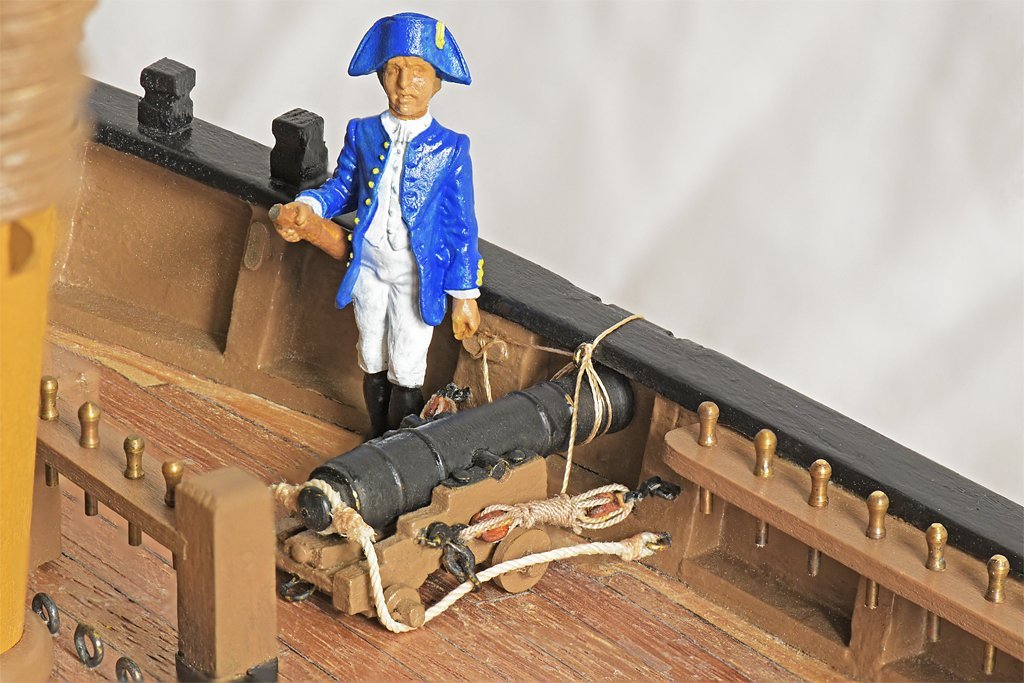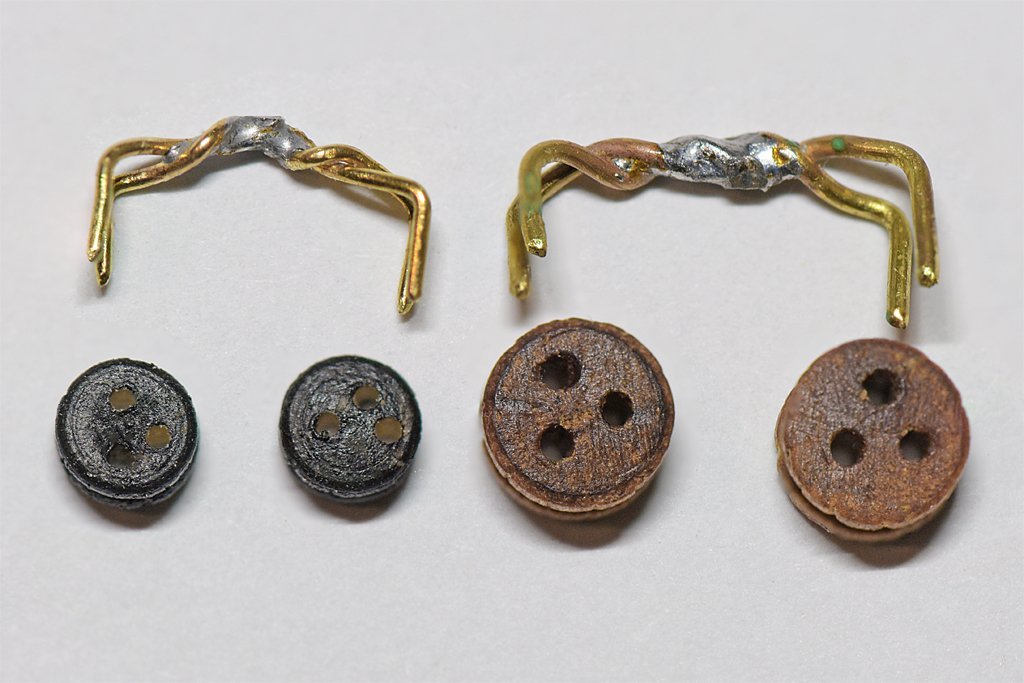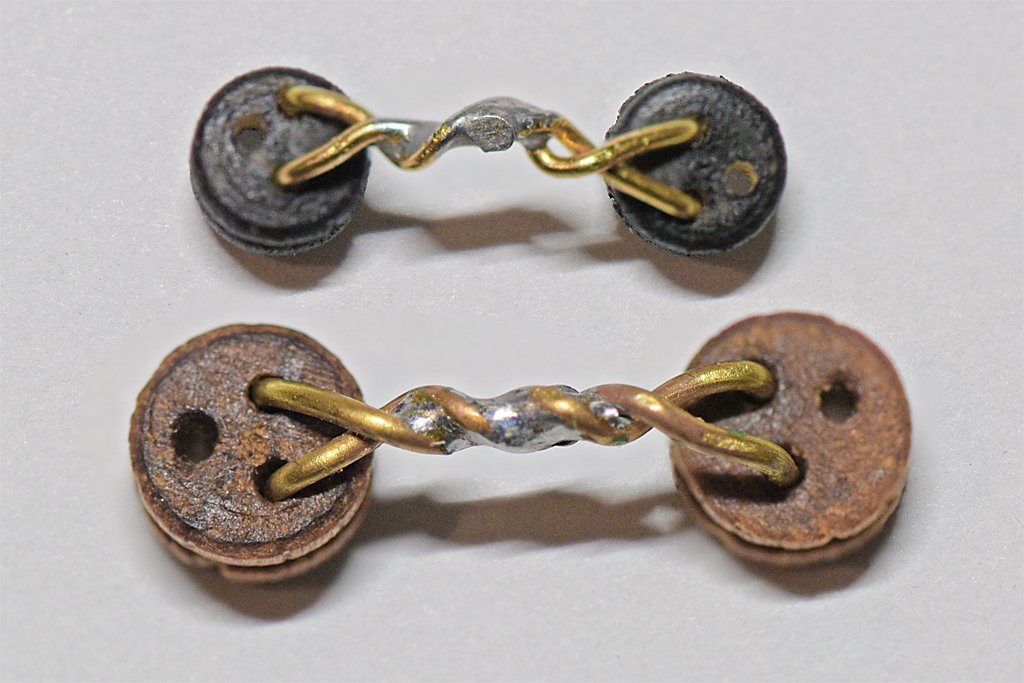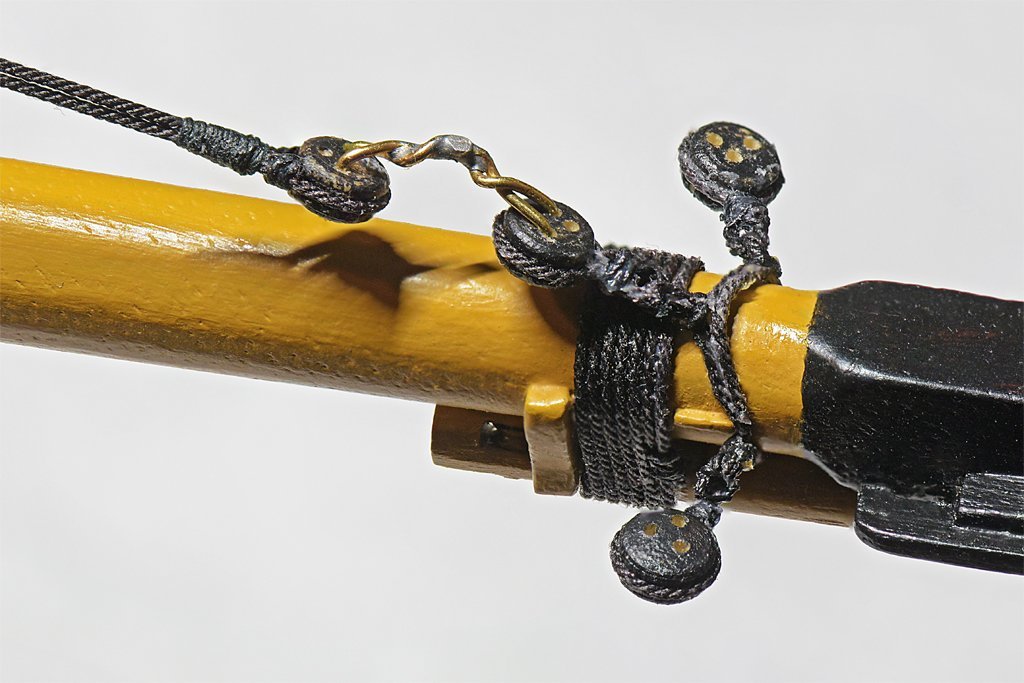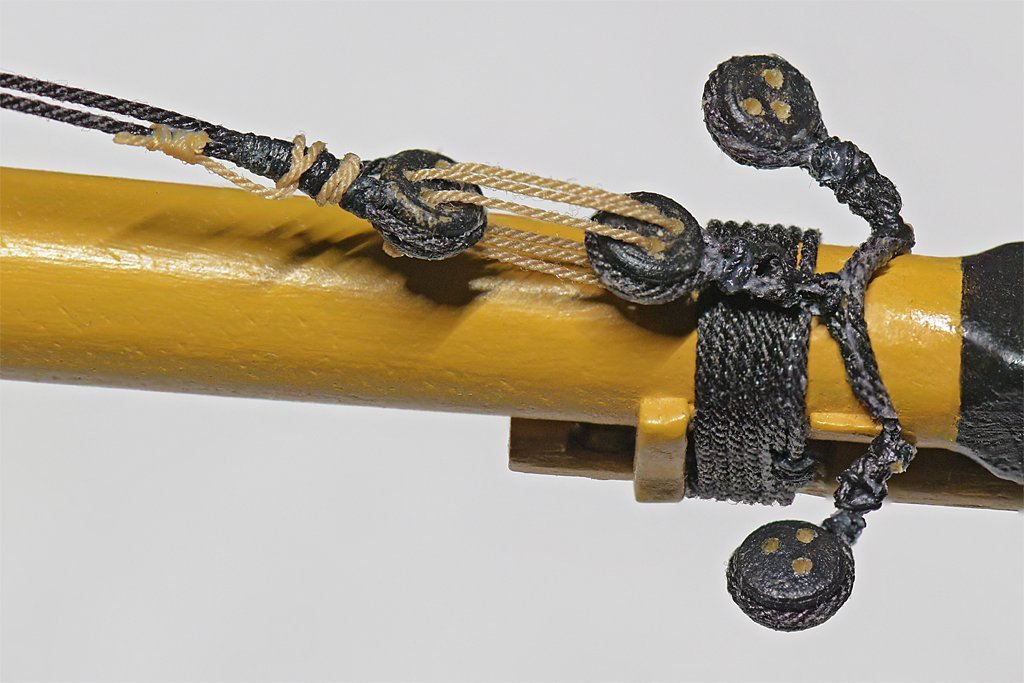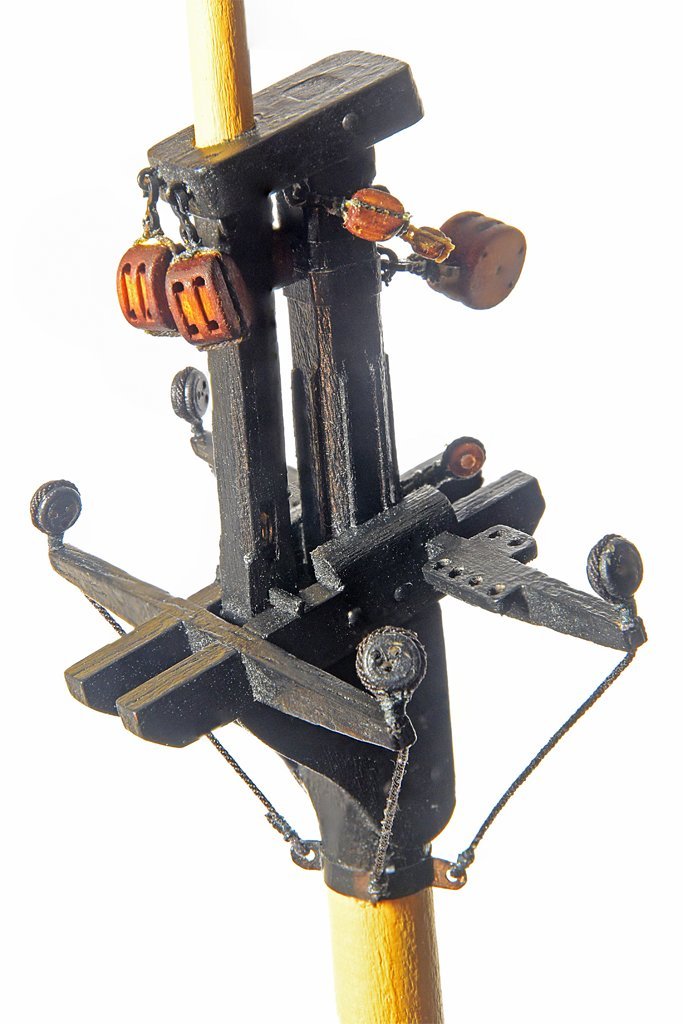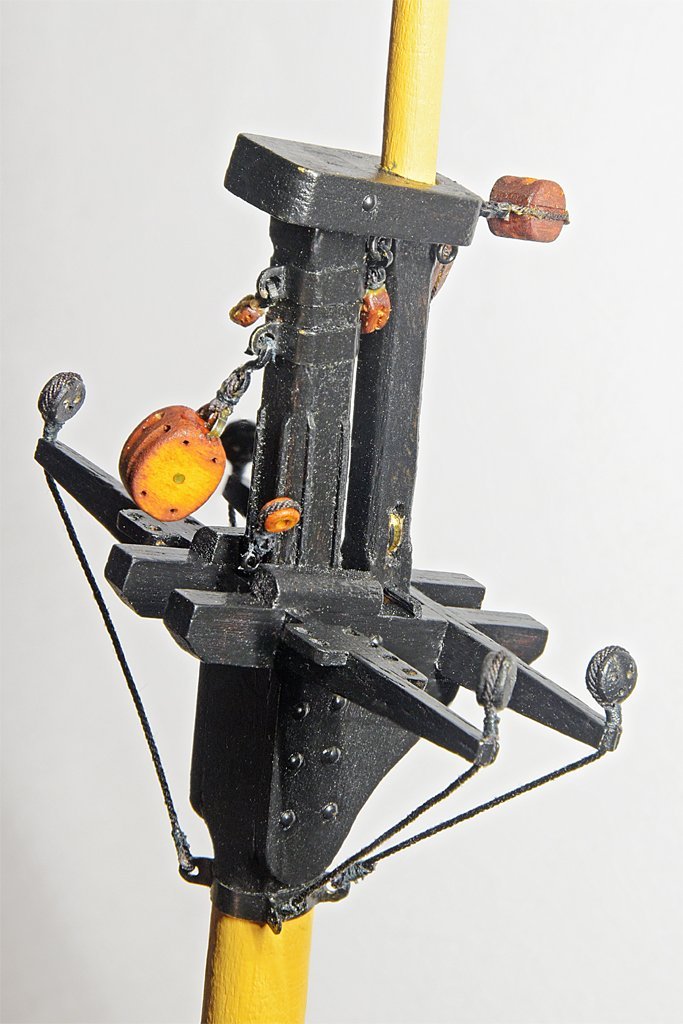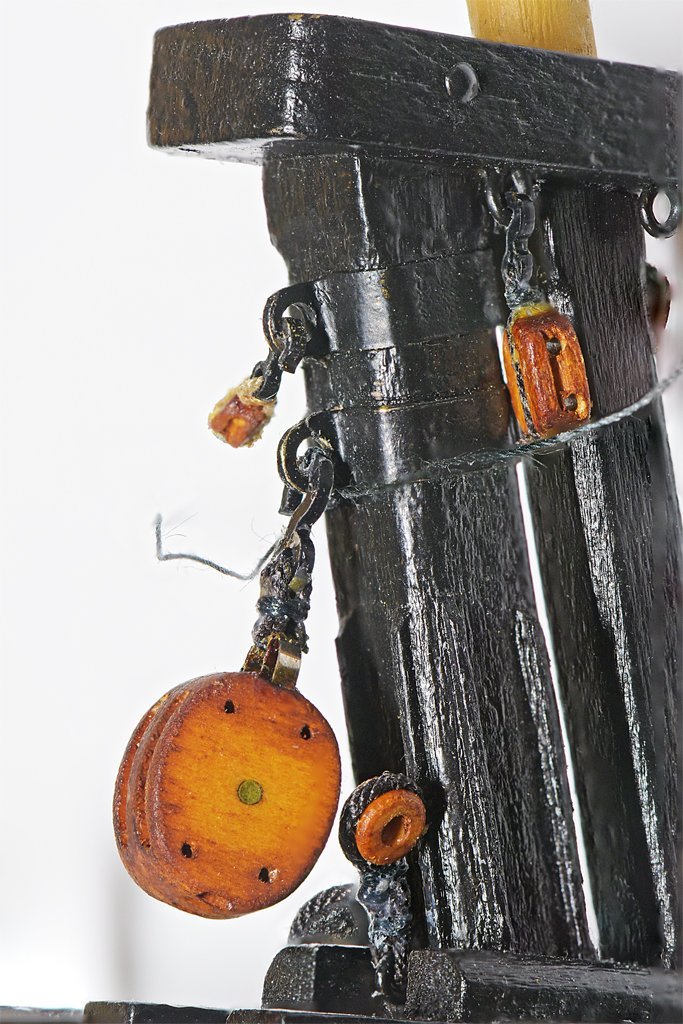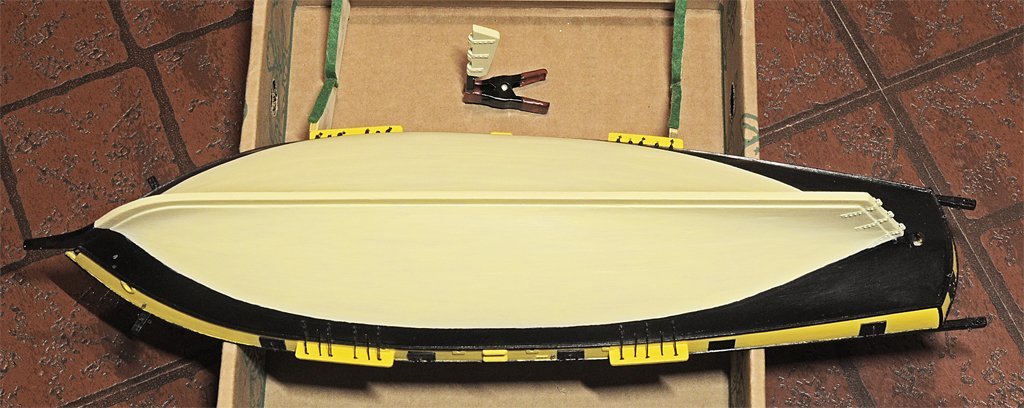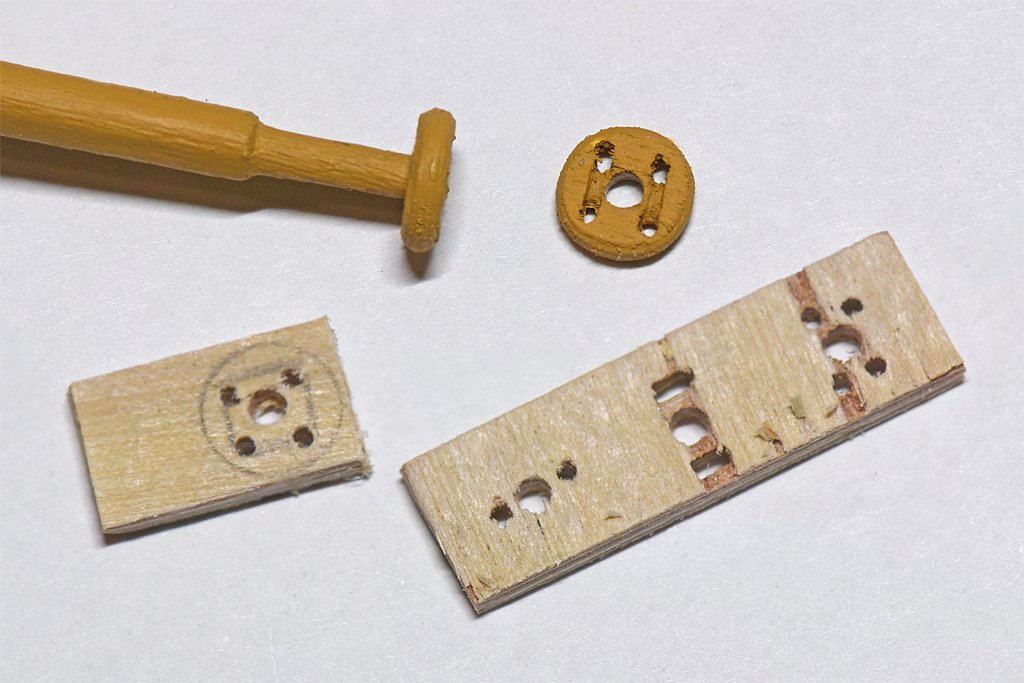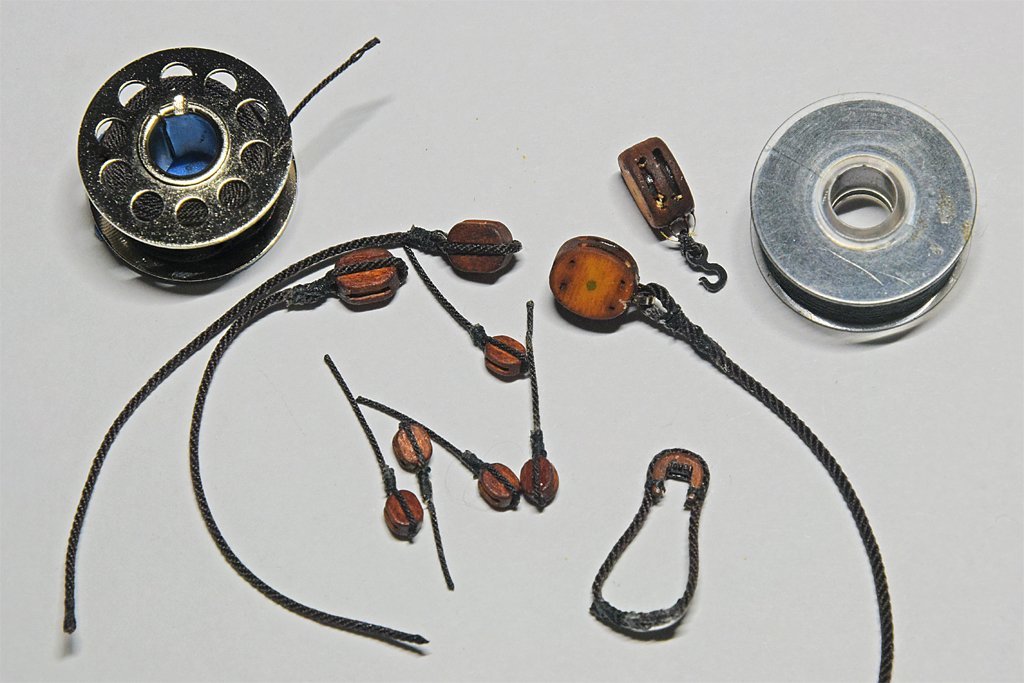-
Posts
2,458 -
Joined
-
Last visited
Content Type
Profiles
Forums
Gallery
Events
Everything posted by Dr PR
-

Rigging the Endurance by Occre
Dr PR replied to David Enghauser's topic in Masting, rigging and sails
David, The Endurance was essentially a three masted topsail schooner. Read through this article to learn about schooner rigging. It discusses two masted schooners, but the Endurance just had a third fore-after mast similar to the main mast in these drawings. https://modelshipworld.com/topic/25679-topsail-schooner-sail-plans-and-rigging/?do=findComment&comment=750865 The rigging names will be similar for the spar and sail rigging, and the kit belaying plan should show where each line is belayed. Keep in mind that no two ships were the same, and even the same ship changed with time. So if you don't have the exact plan for the precise date you are modeling you will have to make a "best guess" for your model. -
George, Rothschild! Brother. You move in different circles from me! The black metal would be very nice for most ship modelling (and model railroading) purposes. I guess if I want the black metal foil I'll have to move up to more expensive wines. Many (30-40) years back I used the small metal tins that held tubular glass fuses. I'm not sure what alloy it was, but some type of steel. It was very thin and easy to cut and form, and it soldered OK. Now everything seems to come in plastic.
-
John, I don't know if I would call it a "fine" metal, but so far it has been in abundant supply. I guess it's greatest virtue is that it is soft and easy to work. Of course, that property rules it out for many jobs. I have noticed that the thickness varies quite a bit from winery to winery. And some companies are using plastic, so the metal seals may go the way of the wine cork.
-
Some authors say that masts were protected from chafing by booms and gaffs with a metal plate. I decided to try this on this model. The catch was trying to determine the proper location on the masts without having the rigged gaffs in place. But after the gaffs were (mostly) finished I could measure the length of the throat halliard tackle with the gaffs in position. Then I determined the dimensions of the metal sheets. I searched through my metals stash for very thin material, and found some special metal sheets that were only 0.0035 to 0.004 inches (0.09 to 0.1 mm) thick. After the paint was scraped off the area the metal was shaped to fit around the mast and then glued (Duco cement) in place. After the glue dried and a bit of touch-up paint on the masts the gaff jaws were filed to slip over the metal plates. Here are photos of the fore mast and main mast with the metal in place. The metal plates wrap 3/4 of the circumference on the aft sides of the masts. I discovered that I made the main boom topping lift pendants too short, based upon my original drawings that showed the gaff hoisted too high on the mast. You can see on the right that the blocks hang down to about where the gaff will be. They should be somewhat lower so they don't bump on the gaff. Well, if you have done much scratch building you know that a lot of the work will have to be repeated! Could be worse!! Here is the boom rest on the main mast with the jaws of the boom in position. There is still a lot of work to do on the boom and gaffs. There are metal bands around the jaws, and I intend to drill through the jaws and mast and pin them together with wire for added strength. And there are several cleats, thumb cleats, metal bands and ring bolts still to be attached. And what was that "special metal" that I used for the chafing plates? Well, it is something I have in nearly unlimited supply and it is very easy to work with. But oddly, I do not recall ever using it before. You can see the original source here, around the top of the wine bottle. It is the metal alloy used to seal the bottle. Just cut it off and roll it out. I sanded the painted side to get better "tooth" for the glue to adhere to. Cheers!
-
Roger is right about trying to nail or screw into the edge of plywood. I think it is OK for bulkheads IF you are just going to use glue to fasten the planking. But if you will be using fasteners or treenails solid wood bulkheads will be better. I got my model aircraft plywood at the local hobby shop that had a lot of R.C modeling supplies. Unfortunately, the Internet and big box stores have starved it to death, as they have also done to our local camera shops.
-
Before I can finish the rigging on the mast tops I need to check some dimensions with the gaffs and boom. So making these was the next project. I took spar lengths from the model rigging plan and created a 2D CAD drawing using the prototype spar dimensions from Marquardt's The Global Schooner. I think these dimensions are probably more accurate for schooners than the square rig spar dimensions from other books. The parts were carved out of square dowel stock. If you haven't tried making masts and spars this way it is something to consider. It is very simple and quick. First I drew the spar outlines in pencil on the faces of the square dowels. Then I used a small plane to remove most of the excess material - this produces a lot less sanding dust than trying to just sand the stock down to size. The final shaping was done by sanding on coarse sandpaper. After the square cross section spars are done the edges are shaved off with the plane to create an octagonal cross section. With small spars like these I them just finished rounding the pieces with sandpaper. The photo above shows the rough shaped spars and the stock they were carved from. Below are the rounded spars. Next were the jaws for the boom and gaffs. I printed the drawing of the spars and cut out the part with the jaws. After cutting out the jaw pattern I used it as a template to pencil in the outline of the jaws on thin pieces of plywood. Again, this was made by gluing two pieces of 1/32 inch (0.8 mm) model aircraft plywood together and allowing the glue to harden overnight. It is easier to carve small details without the wood breaking with the plywood than with just a thin piece of wood. Two of each jaw pattern were made. However, tough as the plywood is, one piece broke and I had to make another one to finish the job. The pieces were glued together with Duco cement. This is an acetone based solution of nitrocellulose. It dries quickly and sets in a few seconds. I followed the instructions and coated the mating surfaces with glue and let it dry, Then I added a new layer of glue and clamped the pieces together. It set firmly in less than a minute and made a strong bond. After curing overnight I sanded the parts and coated them with shellac to seal the wood. I will add metal bands around the jaws and spars, and some additional details later. But for now I can use the pieces to measure the length of some of the mast rigging (throat halliards in particular).
-
This is an excellent choice for a first scratch build project. The hull doesn't have complex curves and there is not an extreme amount of superstructure or rigging to deal with. The 1:35 scale allows a tremendous amount of detail, and there is a large amount of military tank and vehicle parts and figures available that might be useful. I have see a couple of beautiful 1:35 scale PT moat models. Personally, if you are building out of wood I would use 1/8 inch model aircraft plywood for the frames and keel. This way you would need only a sheet or two of the plywood, and would be working with only one type of material. I like the good quality aircraft plywood because it doesn't split along the grain like some woods tend to do. This is especially true for small thin parts that must be hand shaped a lot. You could use the really thin (1/64") model aircraft plywood for the hull plating - it does bend pretty much like paper. But is is fragile, and it would be easy to poke holes in the thin stuff between bulkheads. I guess planking would be the way to go if you use wood. Another way to build it would be to use styrene for the hull keel, frames and surface. You can cut paper templates and use these to shape the plastic. You can heat it with a hair dryer to get it to curve in the right places (don't over do it though).
-

Best paint for wooden ship models
Dr PR replied to Hsae's topic in Painting, finishing and weathering products and techniques
Bob, I usually remove the masking tape before the paint dries to avoid lifting the dry paint. However, this is tricky, because it is a guessing game to decide when the paint is dry enough but not too dry. -
The fuzz on scale rope should also be to scale. If the fibers on 1:1 rope are 0.001 inch (0.025 mm) - 5 times the diameter of a human hair - the scale fuzz would be 0.00002 inch (0.0005 mm) at 1:48 scale. You would need a microscope to see them. From a normal viewing distance the ropes on a scale model would have no visible fuzz.
-

Best paint for wooden ship models
Dr PR replied to Hsae's topic in Painting, finishing and weathering products and techniques
One of the advantages of acrylic paints is that they dry quickly - or so we are told. I began painting (artistic) about 65 years ago with oils, and it was frustrating having to wait weeks for them to dry. I was enthusiastic about working with "fast drying" acrylics. They do dry relatively quickly (an hour or less) so you can apply a second coat. It is best to apply several thin coats rather than one thick coat. However, they do not harden until a week or two after application. Before this you can scrape them off with a finger nail! Here is a trick I learned on the forum for using tape. Paint a part of the hull (upper/lower) with the appropriate color and let it dry thoroughly. Then apply the tape over the painted part. Now paint over the edge of the tape with the same color. If anything bleeds under the tape it will be the same color as under the tape and, therefore, not a problem. This will seal the edge of the tape so nothing else can bleed under it. Then paint the other part of the hull. If you have a slight raised edge when the tape is removed carefully scrape it with the edge of a hobby knife to remove the raised edge. I suggest trying this first on something you don't care about because it requires a bit of practice to get the technique down. You can also gently sand the raised edge and then apply a clear coat over it to get a smooth finish. -
I have installed the starboard anchor. This anchor is secured to the rail with the shank painter and the stopper ropes. These lines are secured to timber heads on the rails and belayed to cleats on the bulwark. When secured this way the anchor cable is detached and stowed, and the cat tackle is not attached. I haven't installed the port anchor yet - it is just sitting on deck for size reference. I am planning to have it in a position supported by the fish davit and fish tackle attached to the fore tackle. The anchor cable will be attached and the head of the anchor supported by the cat tackle attached to the ring. This would be the configuration for hoisting the anchor up to the position on the rail while weighing anchor. I have discussed this rig in this link: https://modelshipworld.com/topic/27410-small-ship-anchor-handling/?do=findComment&comment=787942 I have also been working on the tiller tackle for steering the ship. I should say that this configuration is a bit speculative for the early 1800s. It is in use today on the vessel Lady Washington, but I do not know when this exact arrangement came into use. It was common to have tackle attached to the tiller as far back as the early 1700s. Some models and drawings show two separate tackles attached to port and starboard sides, with the falls led forward and belayed. But I have seen photos of a model of a topsail schooner from the early 1800s with this rig, although I have no idea how accurate it is. The tiller tackle serves two purposes. First, it acts as a shock absorber to absorb forces generated in following seas when waves slap the rudder and swing the tiller. The friction of the ropes running through the blocks and the mechanical advantage of the tackle reduce the rate of the tiller swing, making it easier for the helmsman to control the tiller (and get out of the way as it swings). The tackle could also be used to steer the vessel by hauling on the appropriate fall and slacking the opposite. The rig shown here accomplished both tasks. When the helmsman pushes on the tiller line feeds from the tackle on one side and into the tackle on the opposite side. This reduces the rate the tiller swings, but also give mechanical advantage to the helmsman against the forces of the waves. In modern rigs a latch is attached to the top of the tiller where the line crosses. Pressure on the latch slows the rate of tiller swing, and if the latch is secured hard on the line it serves as an "iron mike" to hold the rudder at a steady angle.
-
That isn't always the case. There is more discussion here: https://modelshipworld.com/topic/34708-tiller-tackle/#elControls_989249_menu The tiller tackle arrangement shown below is sometimes used. The latch allows the rudder to be secured at a desired angle - sort of an "Iron Mike" for holding course. The vessel is the Lady Washington. The tiller tackle in Steve's photo does accomplish two things. First, as the rope slides over the notch in the top of the tiller handle there is friction to slow the tiller movement. Pressing down on the rope would increase friction. There are mechanical devises available today to actually control the friction better, allowing the helmsman to move the rudder but still resist movement caused by water action. Secondly, the friction in the tackle as the ropes run through the block act as a damper to minimize sudden movement of the tiller. It acts as a shock absorber. I am still trying to figure out when this arrangement first came into use.
-

Focus Stacking
Dr PR replied to Dennis P Finegan's topic in Photographing your work. How to do this.
Very good explanation. Another issue, especially with macro lenses, is that as you change focus the area included in the photo changes size a bit. So any particular object will be different sizes relative to the overall frame size in different images. Photoshop has a "Edit/Auto-Align Layers" function that resizes each layer so objects common to all are the same size - and maybe "stretched" a bit to the same overall outline. But the result is that the outer edges of the stacked photos can be blurry. I always back off enough that the photo frame is a bit larger than optimal, and crop the edges in the final picture. Photo stacking isn't perfect, but you can get extraordinary depth of field if you use it correctly and don't mind doing a bit of post-processing touch-up. -

Focus Stacking
Dr PR replied to Dennis P Finegan's topic in Photographing your work. How to do this.
I use an older version of Photoshop (CS5) and the focus stacking works only marginally. It is especially bad where a near object, like a rope, passes in front of a more distant object. The distant object will be blurred slightly on either side of the closer object. I have to do a lot of touch up, but I get acceptable pictures. My cameras don't do focus stacking internally. That's something to look for in future purchases. -
I have finished the bowsprit standing rigging. There are probably as many variations on this as there were ships, but the configuration I am using was found on some smaller vessels. You can see the octagonal bowsprit housing in this photo, with the heel stepped between the two bits. I added two cleats for belaying miscellaneous lines. I had to wait until the bowsprit was installed to add these because they wouldn't pass through the hole in the bow. The open heart for the forestay also could be installed only as the bowsprit was being put into place. I found this Amati cast metal figure on line, and use it to show the scale. However, it is a peculiar size - 35 mm high. At 1:48 this makes the fellow about 5.6 feet tall (1,7 meters) with hat, or about 5.2 feet without the hat. So it is really about a 1:55 scale figure, assuming the fellow is 5' 6" tall (1,7 meters). Why would anyone make a 1:55 scale figure?? Either people were shorter 200 years ago, or perhaps this is a midshipman! Perhaps it is Napoleon's cousin? Anyway, it does give a general idea of the size of things. I would like to find an actual 1:48 scale (O scale) figure 35-38 mm without hat or 37-40 mm with hat. The gammmoning fastens the bowsprit to the knee on the stem or head of the ship. The jib boom guys attach to the catheads with 3.5 mm deadeyes. Some vessels used hearts and others used thimbles. The lanyards are half the diameter of the guys or shrouds and are belayed by taking a few turns around the guy and securing with seizing. The bowsprit shrouds (port and starboard) are secured to eyebolts below the catheads. The eyebolts below the hawse openings will secure the jib stay (stbd) and preventer (port). Below these the martingale backstays (P & S) attach to eyebolts with deadeyes and lanyards. The bobstay is doubled, passing through a hole in the stem and secured with seizing. The bowsprit head is the belaying point for several lines. The martingale (dolphin striker) is attached to the bowsprit cap. At the bottom end is a metal fitting where the two martingale backstays are secured on the aft side (left in the photo). On the fore side the aft end of the martingale stay is belayed. The other end has an eye looped around the end of the jib boom. You can see the traveler on the jib boom and the sheave in the base of the boom for the jib boom outhaul (not rigged). The deadeye on the starboard side of the front of the bowsprit cap is for the foretop stay. The flying jib stay (traveler outhaul) tackle will attach on the port side of the bowsprit cap. The most complex part of the rigging is the bobstay collar. This has three deadeyes attached to it. The port and starboard deadeyes are for the bowsprit shrouds. The center deadeye is for the bobstay. I made the collar a bit too loose. It is supposed to fit tight in front of the three thumb cleats attached to the bowsprit, but you can see that it actually rides over the two thumb cleats on the sides of the bowsprit, and is hooked in front of the top one only. Here are a couple more pictures to show scale, with the 12 pounder pivot gun on the left and a 6 pounder carriage gun on the right. And finally, a photo of the entire ship as it stands today. The masts have not been installed permanently. I am still working on some of the rigging that will be easier to attach with the masts off the ship.
-
The books say to just lash the free end to the nearest loop of the gammoning with seizing. That is what I did on my model.
- 106 replies
-
- Grecian
- baltimore clipper
-
(and 4 more)
Tagged with:
-
Free at last, free at last!!! Taxes are done and now I can get back to important things like ship modeling! Only some small progress to report. I am adding rigging to the mast and bowsprit that will be easier to install before the assemblies are added to the hull permanently. Lots of blocks and such. I have actually installed the bowsprit onto the ship, and am working on the stays. One thing I needed to do was make tools for setting the spacing between deadeyes. The vessel has 5 mm deadeyes on the channels and 3.5 mm deadeyes in the tops and in some rigging on the bowsprit. Here are photos of the tools. I saw this in another post on the forum and it is an easy and simple way to achieve constant spacing. I selected brass wire a bit smaller diameter than the holes in the deadeyes, twisted two pieces together and soldered them. Then I shaped and cut them to space the deadeyes the desired amount - 0.75" (19 mm) for the 5 mm deadeyes, and 0.5" (13 mm) for the 3.5 mm parts. You can't get much simpler than that! Here are photos of the tool in use. These deadeyes are on the bobstay. The bobstay deadeye is part of a collar with deadeyes on either side for the bowsprit shrouds. The tool was used to position the left (in the photo) deadeye while the bobstay was secured around it with seizing. Then the tool was removed and the lashings added to draw the stay taut. The free end of the lashing was looped around the stay and the end secured with a lashing. With this the rigging of the bowsprit has commenced! Note: I wondered if the lanyards should be dark brown like the stays, or lighter tan like the running rigging. The general opinion on the forum is that they are the lighter color. I consulted several of the standard references and did not find an answer. However, lashings must be fairly limber to be able to pull them through the deadeyes, hearts, thimbles and such (Lever says to grease the lanyards good so they can be pulled very tight), so they are considered running rigging. The ropes of the running rigging are tarred as they are made, but no extra tar has to be added before use. The running rigging wears out and is occasionally replaced, so it is typically light in color. In contrast, the more permanent standing rigging periodically was retarred for protection from the elements and was usually darker.
-
shipman, My thoughts exactly! My first ship was a 112 foot inshore minesweeper USS Cape MSI-2. It bounced around like a cork in heavy seas. We walked (or crawled) on the deck, bulkheads, passage walls, whatever, hanging on for dear life all the time. The open bridge submerged occasionally when we dove into waves, and we had water sloshing over our feet for the entire watch. 112 feet (34 meters) is FAR too small to be out on the ocean!! The Cyclone class destroyers were only 45 meters (147 feet)! Still too small in my opinion!!!
-
Valeriy, You are right about the photos. During a ship's service a lot of modifications can be made, but most are not documented. If we have plans they are usually for the initial design. A few years after there may be a lot of modifications. In some cases it may never be clear exactly when changes were made. In an early photo the modifications are not there, and a photo from a few years later shows them. However, in some cases we can be more certain. While working on my OK City model I found two photos made a day apart, with an obvious change in the later photo. It is rare to be able to pin down a date with that accuracy!
-
Pete, I wondered about the same thing. There are a few threads about gun tackles. Here is what I ended up doing: https://modelshipworld.com/topic/19611-albatros-by-dr-pr-mantua-scale-148-revenue-cutter-kitbash-about-1815/?do=findComment&comment=1003150 I have seen this used on several models and some museum ships. I have also seen drawings of the falls coiled on the side of the gun carriage like this: https://modelshipworld.com/topic/19611-albatros-by-dr-pr-mantua-scale-148-revenue-cutter-kitbash-about-1815/?do=findComment&comment=1004278 You are right about the ropes coiled on the deck. There is no way a ship at sea would have loose ropes flailing about the deck! This is a common practice on museum ships today, and might have been used on the real ships when they were open for visitors. It is just for show.
-
John, Thanks! There will now be a slight delay while I do the taxes for a non-profit I am Treasurer for. Form 990 makes all the other tax returns I have done (1040, Form C, Form R, etc.) look simple. About 120 pages of instructions and 12-15 pages of forms including schedules. It is very tricky and will take at least a week, sometimes two.
-
More work on the masts and bowsprit in preparation for starting the rigging. First are the trucks at the mast tops. These are about 0.20 inch or 5 mm diameter and are supposed to have two sheaves for raising flags and pennants. I just made two pairs of holes and cut a channel between them to simulate the sheave. The material is 1/16 inch (1.58 mm) aircraft plywood - I tried making them out of regular wood and it kept splitting as I was drilling and shaping them. I didn't have 1/16 inch plywood, but I did have 1/32 inch (0.8 mm) plywood, so I glued two pieces together. It took several attempts to get three pieces - one spare in case another one disappeared. The mast tops have a bunch of blocks for running rigging attached to them. I wanted to get these in place before installing the spars and booms (yet to be made) and placing the shrouds. Rigging the tiny blocks is tedious! I used Syren rope (on the metal thimble) for the pendants and Syren hooks. The seizing is a very tiny (0.005 inch or 0.13 mm) black line (small stuff) that I got years ago with some model kit - maybe even this one. I tie an overhand knot around the ropes and add a drop of white glue. Then I wrap (serve) the line around the rope and finish the seizing with another overhand knot. The seizing is then soaked in white glue and after it dries the ends of the rope and seizing are trimmed. Here is the top of the fore mast. The main mast top is a work in progress. The large (5/16 inch or 8 mm) double block for the gaff peak halliard caused a bit of a problem. The 5 mm hook fit loosely into the hole in the mast band, and could be shaken off fairly easily. I tried mousing it but the knot kept slipping off (this is pretty small work). Here is my solution. I tied an overhand knot of the 0.005 inch (0.13mm) small stuff around the hook, and then another overhand knot around the mast band eye. A small drop of white glue secured the knots. The knots were positioned so they are under the hook and mast band when the block is rigged, and will not be visible. Here you can see the loose ends of the small stuff while the glue dried. Then the ends were trimmed back to the knots. While I was working on all of the small parts I also painted the bottom of the hull. I used a mixture of white paint with a drop of yellow to simulate the tallow/white lead/turpentine mix used on small vessels. I have put this off while making all the deck furniture, cannons and masts because the hull was handled quite a bit. But this needed to be done before adding the anchors and starting the rigging.
About us
Modelshipworld - Advancing Ship Modeling through Research
SSL Secured
Your security is important for us so this Website is SSL-Secured
NRG Mailing Address
Nautical Research Guild
237 South Lincoln Street
Westmont IL, 60559-1917
Model Ship World ® and the MSW logo are Registered Trademarks, and belong to the Nautical Research Guild (United States Patent and Trademark Office: No. 6,929,264 & No. 6,929,274, registered Dec. 20, 2022)
Helpful Links
About the NRG
If you enjoy building ship models that are historically accurate as well as beautiful, then The Nautical Research Guild (NRG) is just right for you.
The Guild is a non-profit educational organization whose mission is to “Advance Ship Modeling Through Research”. We provide support to our members in their efforts to raise the quality of their model ships.
The Nautical Research Guild has published our world-renowned quarterly magazine, The Nautical Research Journal, since 1955. The pages of the Journal are full of articles by accomplished ship modelers who show you how they create those exquisite details on their models, and by maritime historians who show you the correct details to build. The Journal is available in both print and digital editions. Go to the NRG web site (www.thenrg.org) to download a complimentary digital copy of the Journal. The NRG also publishes plan sets, books and compilations of back issues of the Journal and the former Ships in Scale and Model Ship Builder magazines.



